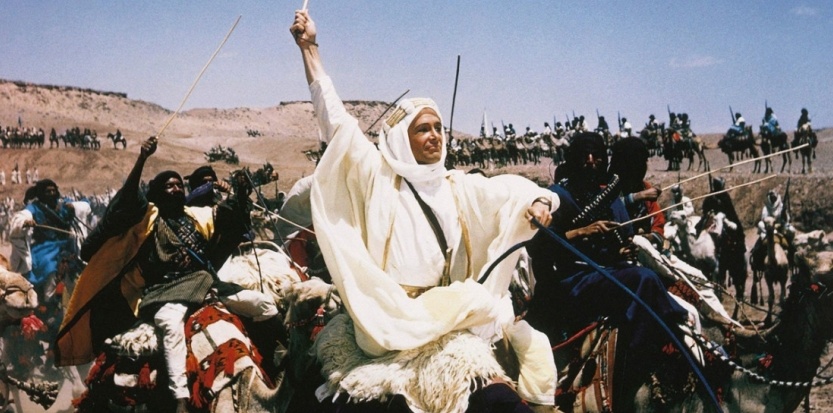Recommended movie: “Lawrence of Arabia”
The man who dreamed awake
“All men dream, but not in the same way. Those who dream at night in the dusty recesses of their minds, wake up by day, discover that all was in vain. But, daytime dreamers are dangerous at home because they dream with their eyes open to make them possible. This I did.”
The Seven Pillars of Wisdom (Introductory Chapter, suppressed)
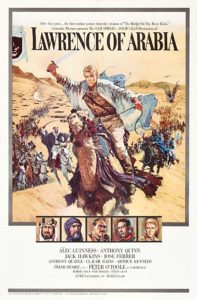 One of the most popular myths of the twentieth century was T. E. Lawrence, better known as Lawrence of Arabia. Lawrence, who was English, played a major role in the Middle East campaign during the First World War. Strong and controversial personality, he was very far from the standard of the traditional British soldier. In addition to disregarding the military habits of his country, he was a great supporter of an independent Arabia. If we consider that England was the greatest colonial empire of the time, one can have an idea of the sacrilege of Lawrence’s thought.
One of the most popular myths of the twentieth century was T. E. Lawrence, better known as Lawrence of Arabia. Lawrence, who was English, played a major role in the Middle East campaign during the First World War. Strong and controversial personality, he was very far from the standard of the traditional British soldier. In addition to disregarding the military habits of his country, he was a great supporter of an independent Arabia. If we consider that England was the greatest colonial empire of the time, one can have an idea of the sacrilege of Lawrence’s thought.
Lawrence’s story, especially the adventurous period in which he fought in the desert, was brilliantly brought to the screen by David Lean after an equally difficult and costly production, “Lawrence of Arabia” (UK,1962).
 To better understand the myth, let us transport ourselves to the environment where Lawrence acted. In the early twentieth century, if Europe was already experiencing the modernism of the Industrial Revolution, the rest of the world was a universe of underdeveloped colonies tied to the great powers of the time: England, France, Germany and Russia, the latter already living the ruts of the dynasty Romanov. The Middle East was a no-man’s-land, occupied by nomadic tribes, who spent most of their time warring among themselves.
To better understand the myth, let us transport ourselves to the environment where Lawrence acted. In the early twentieth century, if Europe was already experiencing the modernism of the Industrial Revolution, the rest of the world was a universe of underdeveloped colonies tied to the great powers of the time: England, France, Germany and Russia, the latter already living the ruts of the dynasty Romanov. The Middle East was a no-man’s-land, occupied by nomadic tribes, who spent most of their time warring among themselves.
The communications were terrible, and the great medium of news was still the written press, with all its ills. In this environment, war was a distant subject for most people, and even in Europe, it was impossible to imagine the horror of the reality of the trenches, which killed and maimed millions of men.
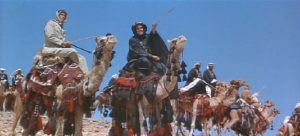 What people imagined from Arabia, for example, were the Arabian Nights and the adventure novels, usually written by people who had never visited.
What people imagined from Arabia, for example, were the Arabian Nights and the adventure novels, usually written by people who had never visited.
In this fertile ground, the intense coverage that the American journalist and writer Lowell Thomas did in 1919, about Lawrence’s participation in the war, elevated him to the status of myth. Deeply involved with the cause of an independent Arabia, Lawrence used his own success to garner sympathy to the movement.
This heyday of fame coincided with the Peace Conference in Paris, where the winning nations decided the fate of the rest of the world. Despite being linked to the British delegation, Lawrence stayed with the Prince Faisal, battling for adherents to Arab freedom.
 Contrary to promises made during the war, Britain and France retained their imperialist ideologies, incorporating Syria, Palestine, and Mesopotamia (present-day Iraq) into their colonies. Disappointed, Lawrence devoted himself to his first great book “The Seven Pillars of Wisdom”, where he told of his adventures.
Contrary to promises made during the war, Britain and France retained their imperialist ideologies, incorporating Syria, Palestine, and Mesopotamia (present-day Iraq) into their colonies. Disappointed, Lawrence devoted himself to his first great book “The Seven Pillars of Wisdom”, where he told of his adventures.
From then until his death in 1935, in a motorcycle accident, Lawrence dedicated himself to activities inside and outside the government, living with the dictatorship of fame. One of his last and valuable contributions was the development of speedboats for the rescue of shipwrecked people.
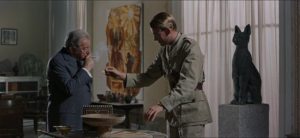 Lean’s movie, despite beginning with Lawrence’s death, is restricted to the period when he was most active in Arabia during World War I. Lawrence’s performance at the Paris Conference was portrayed in a more recent film, “A Dangerous Man: Lawrence After Arabia” (USA, 1990), with Ralph Fiennes in the lead role.
Lean’s movie, despite beginning with Lawrence’s death, is restricted to the period when he was most active in Arabia during World War I. Lawrence’s performance at the Paris Conference was portrayed in a more recent film, “A Dangerous Man: Lawrence After Arabia” (USA, 1990), with Ralph Fiennes in the lead role.
Although it was made in the conservative sixties, Lean managed to convey a lot of fidelity to the facts narrated. To do so, he moved an immense team into the Jordanian desert, where it took two years and three months to complete the filming.Innovative techniques were used, at a time when special effects were made “on the arm”, and no one even dreamed of using computers.
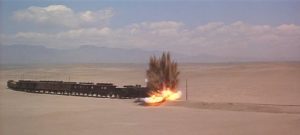 Entire cities had been built for locations, while armies of men and camels were selected and trained for collective scenes. Jordan’s own army was put at the disposal of the production by the king of the country, who was a big fan of movies.
Entire cities had been built for locations, while armies of men and camels were selected and trained for collective scenes. Jordan’s own army was put at the disposal of the production by the king of the country, who was a big fan of movies.
The cast was chosen judiciously. For Lawrence’s role, Lean wanted a theater actor, who had never made movies before, casting down the choice in Peter O’Toole, elevating him to superstar status. Alec Guinness, who had previously performed with Lean in the blockbuster “The Bridge on the River Kwai”, was selected for the imposing prince Faissal. Former veteran Anthony Quinn was the American name to participate in the production.
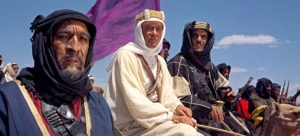 When looking for someone local to the role of Sheriff Ali, they decided to test an unknown actor, known only in their country, Egypt: Omar Sharif. The character Ali, apparently secondary, was a kind of Talking Cricket from Lawrence, and gave Sharif an Oscar nomination, along with O’Toole.
When looking for someone local to the role of Sheriff Ali, they decided to test an unknown actor, known only in their country, Egypt: Omar Sharif. The character Ali, apparently secondary, was a kind of Talking Cricket from Lawrence, and gave Sharif an Oscar nomination, along with O’Toole.
The DVD edition for Latin America came with the same richness of detail as American one. The film has almost half an hour more than the version that arrived in theaters, including Overture and Intermezzo, stretches of four to five minutes with only music, a feature common in the feature films of that age.
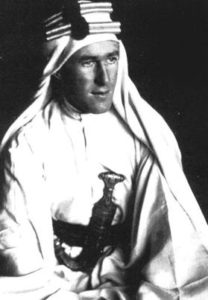 There are two discs, the first part of the film being on one disc, and the continuation and extras on the other. The film comes in Widescreen format, as one would expect for such a work, and audio in English (DD 5.1 and 2.0), Portuguese, French and Spanish (DD 2.0). Subtitles are available in Portuguese, Spanish, English, Chinese, French, Korean and Thai.
There are two discs, the first part of the film being on one disc, and the continuation and extras on the other. The film comes in Widescreen format, as one would expect for such a work, and audio in English (DD 5.1 and 2.0), Portuguese, French and Spanish (DD 2.0). Subtitles are available in Portuguese, Spanish, English, Chinese, French, Korean and Thai.
The Extras exist for Brazilians, that is, most are subtitled in Portuguese, including “Wind, Sand and Star: The Making of a Classic”, with more than sixty minutes and “Making Of ‘Romance of Arabia’ , a conversation with Steven Spielberg”, with nine minutes. In addition, it has four short cinedocumentaries, of the time of the filming, besides film trailers and period photos.
Although the later Blu-ray edition brings an even better picture, and DTS-HD MA sound, the DVD edition offered the opportunity to access one of the greatest works of the epic cinema, with impeccable image and sound, plus an edition more complete than the one that was shown in theaters and television.
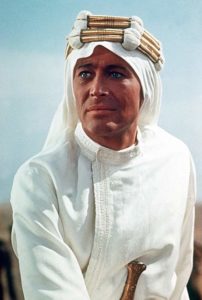 In addition, the documentaries, with testimony from actors like Sharif and Quinn give a special glow to this edition. If it is not the perfect historical testimony, this movie is the portrait of the myth that stirred the imagination of the world in the 1920s.
In addition, the documentaries, with testimony from actors like Sharif and Quinn give a special glow to this edition. If it is not the perfect historical testimony, this movie is the portrait of the myth that stirred the imagination of the world in the 1920s.
To complete the schedule, also look for “A Dangerous Man: Lawrence After Arabia”, and make an unforgettable session. Do not forget to take time, however, because only “Lawrence of Arabia” will hold your attention for more than five uninterrupted hours! Have a good fun!
Original Title: “Lawrence of Arabia”

